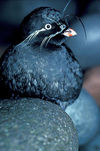Genus Aethia
Crested auklet - The Crested Auklet is recognized primarily by two characters in the breeding season. The first is its 'crest', a group of bristle feathers located above its eye on the top of its head. The second is a social odor that the auklets produce during the breeding season, which has been described as smelling like tangerines.
Parakeet Auklet - The Parakeet Auklet is a small seabird of the North Pacific. It used to be placed on its own in the genus Cyclorrhynchus but recent morphological and genetic evidence suggest it should be placed in the genus Aethia. It is associated with the boreal waters of Alaska and Kamchatka and Siberia. It breeds on the cliffs, slopes and boulder fields of offshore islands, generally moving south during the winter.
Least auklet - Least Auklets feed predominantly on calanoid copepods, particularly those of the genus Neocalanus. They also eat euphausiids, pteropods and other zooplankton species. They hunt for these in stratified waters caused where upwelling and thermoclines cause these prey items to be tightly clumped together. Like all auks they are pursuit divers, using their wings to provide thrust and "fly" under the water. They are voracious predators, consuming 86% of their body weight each day.
Whiskered auklet - The Whiskered Auklet is a poorly studied species and much research needs to be undertaken on the species. It was originally described as two different species, from specimens collected at different ends of its range, however research has shown that it is a single species with clinal variation along its range. It is not thought to undertake migration, but instead attends its breeding islands year round. Whiskered Auklets lay a single egg in a rocky crevice, in loose colonies with other Whiskered Auklets and also other colonial seabirds. Both parents take part in incubation and chick rearing. The whiskers have been shown to help them sense their way to and out of their nests at night.




